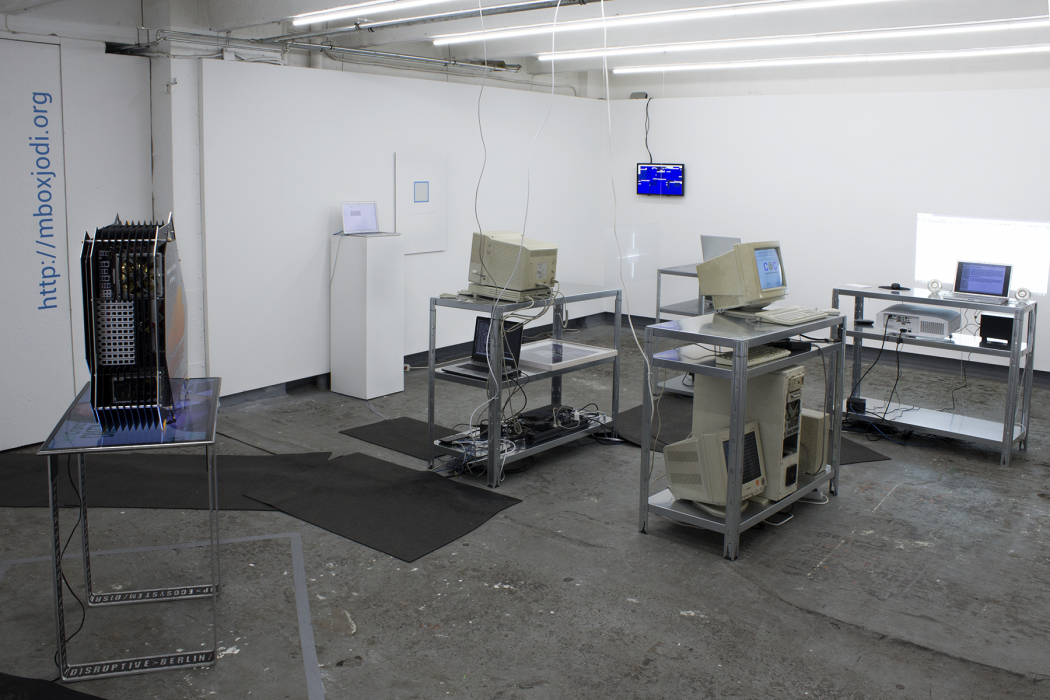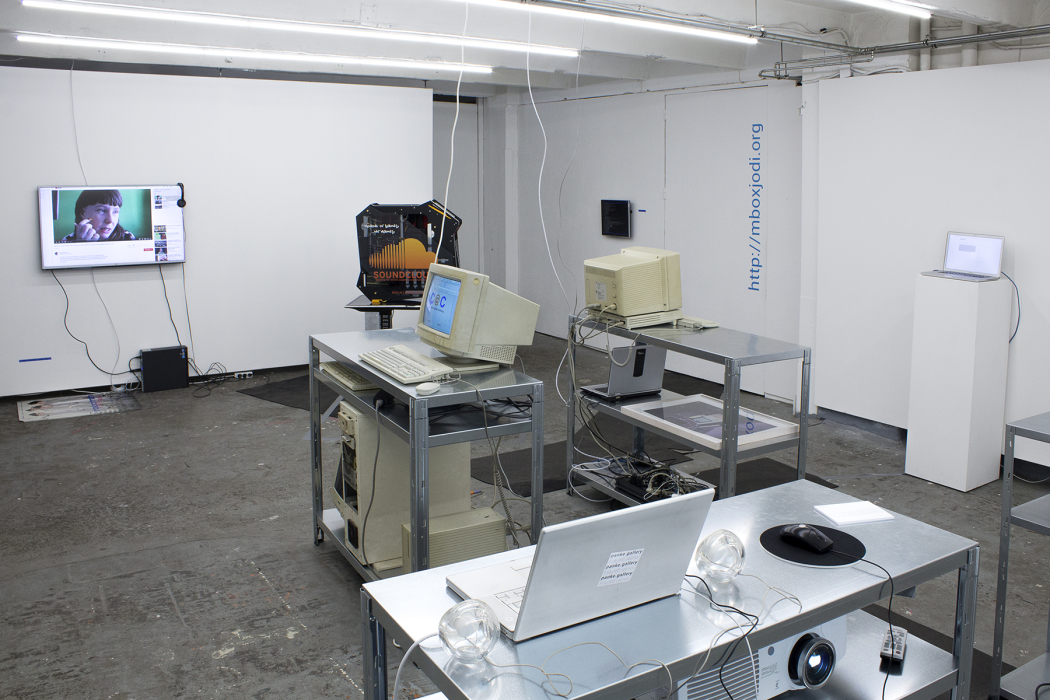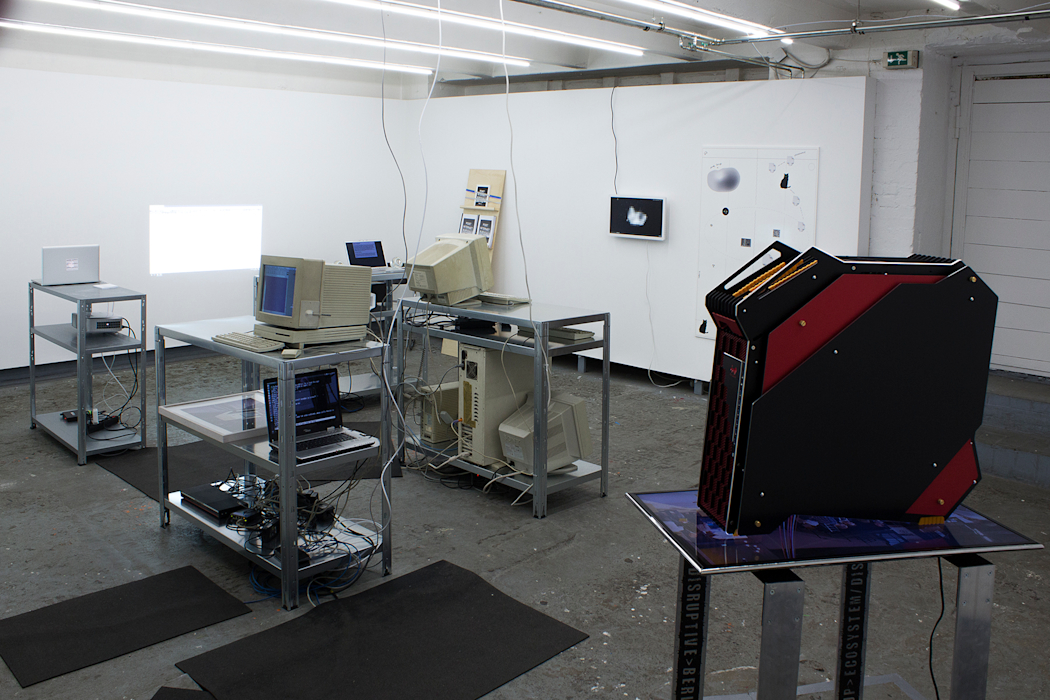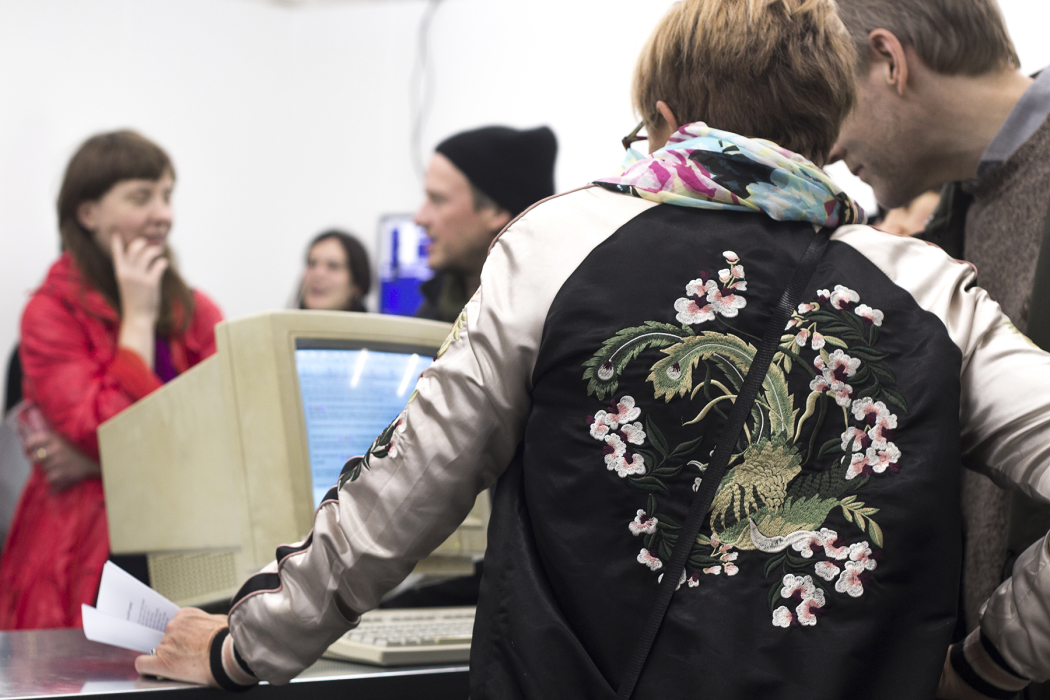Berlin, Zentrum der Netzkunst – damals und heute
Group Show with Nadja Buttendorf | Simon Denny | Harm van den Dorpel | Constant Dullaart | Holger Friese | Eva Grubinger | Internationale Stadt Berlin | Jodi | Jonas Lund | Sebastian Lütgert | Katja Novitskova | Sebastian Schmieg | Cornelia Sollfrank and t.b.a.
About the exhibition
1990s Berlin was one of the centres of net art. In the new spaces of possibility of the reunited city, the first works of net art were techno(logical) and artistic experiments that grew out of the proximity of club and lab, in terms of both protagonists and locations. Inspired by what was then the subcultural movement of techno, artists formed collectives perceiving the net as a medium in which utopias and dystopias of the transition into a digital network society could find artistic expression. The exhibition sets up a dialogue between the net art activities of the 90s – exemplary reconstructed works as well as re-interpretations – and the net art works of the current generation of Berlin-based artists. Many post-digital artists have their roots in the work of the preceding generation’s, and this exhibition seeks to establish that link through its protagonists as well as aesthetically. In this way, the show hopes to experimentally test the thesis that the questions addressed by these artistic investigations have remained the same, although the medium of the net itself is always changing.
More on netzkunst.berlin
Artworks
Nadja Buttendorf — robotron – a tech opera (2018 ongoing) This ongoing web series is an artistic exploration of the development of technology in East Germany, everyday life in the GDR and the Stasi. The result is a DIY YouTube sci-fi soap opera in which the artist plays all the roles herself in a specially created green-screen paradise in her own home. In 1969, the USSR, GDR, Czechoslovak Socialist Republic, and the People’s Republics of Poland, Bulgaria and Hungary signed a multilateral intergovernmental agreement for an Einheitliches System Elektronischer Rechenmaschinen – a standardised system of electronic computers (ESER). The ESER was based on the computer architecture of the IBM 360, which made it inevitable that the Comecon countries would be several years behind the international standard. Despite embargo regulations, there was even a real IBM 360 at the VEB Kombinat Robotron, the Dresden-based electronics manufacturer that built many of the ESER computers. It was completely reverse-engineered, which meant that when the EC 1040, the first ESER Series 1 mainframe was completed at Robotron in 1972, it was compatible with IBM. In the data center of the VEB Robotron, center for research and technology Dresden, stood one of the first computers of the ESER and many people working with it, also colleague H. which works since 1976 as an operator III in the department E43.
Simon Denny — Berlin Startup Case Mod: SoundCloud (2014) In this “sculptural portrait” of SoundCloud – a representative of Berlin’s startup culture – a television monitor is used as a stand for custom computer hardware. Denny refers to the aesthetics of Berlin’s nascent technology industry – its identity as an important hub for startup companies within Europe‘s tech-based economy. The work is part of the series “Disruptive Berlin,” in which Denny unfolds a whole ecosystem in the style of case modding, with reference to the modifications that gamers and hardware enthusiasts use to customise their computers.
Harm van den Dorpel — Deli Near Info (2014 ongoing) Harm van den Dorpel’s project Deli Near Info is a social media website that anyone can join. It exemplifies a non-linear, intuitive “surf”, or way of adding, finding, and connecting user-generated content – particularly images, GIFs, and text. It represents an alternative approach to the ubiquitous timeline-based, scrolling social media sites, which place newer content at the top. Van den Dorpel believes this kind of linear organisation of content is “only about the now”, and does not allow the user to cultivate memory by making associations over time.
Constant Dullaart — defaultism.com, uniformity against arbitrarity (2010) defaultism.com, uniformity against arbitrarity. This work shifts between a number of basic frameworks commonly used as templates for websites. Its specific templates were sourced from Adobe Dreamweaver CS6, a dominant consumer web-design software in 2010. A default, in computer science, refers to a setting or value automatically assigned to a software application, computer program or device. Such settings are also called presets, especially for electronic devices. The Oxford English Dictionary dates this usage to the mid-1960s, alongside various older meanings referring to failures in performance. Default values are generally intended to make a device (or setting) usable “out of the box:, i.e., with minimal user interaction with the device and its potential and constraints.
Holger Friese — unendlich, fast ... (1995/1997/reconstruction 2018) unendlich, fast ... is a single website, “ende.html”, made up of a 2000% wide table, a GIF, the background colour dark blue and the title unendlich, fast ... It was first uploaded to thing.at in 1995. In 1997 it was shown as part of the “Surfaces & Territories” section of the Documenta X website. Around 2000, Holger Friese hosted the work himself on 502.org. Neither thing.at, the original Documenta site, nor 502.org can be accessed on the Internet today. Only the net art project Documenta Done (1997) by Vuk Cosic – a pirated mirror of the official Documenta X website – allows an approximately authentic encounter with Friese’s work. For this exhibition we managed to recover a backup fragment from the original thing.at website and we here present it on a client- server combination that comes close to the historical installation of the work. The page is not interactive: all the viewer can do is click and scroll in the browser interface. The work is made up of transformative and recursive elements. Excessively wide, nested table grids make the loading time almost endless. On the right, mid-screen, is a GIF whose position is determined by the then customary table technique. It shows a screenshot of an open EPS file, which itself displays an infinity sign formulated in PostScript. (EPS files are self-contained PostScript documents that describe an image or drawing and can be placed within another PostScript document.) The medium here seems to contain itself infinitely, to describe itself, and to define its own form. The dark blue background evokes associations to the colour of hypertext links, but here it refers not to something external but to an internal, seemingly endless process of (medium-)reflexivity. Scrolling within this blue does not lead to a sense of immersion, but lets visitors participate in a nearly infinite process of transformation that is produced again and again on the Internet by the interaction of protocols, code languages, hardware and software, as well as their performative deployment.
Eva Grubinger — C@C – Computer Aided Curating (1995/ reconstruction 2018) Eva Grubinger developed C@C – Computer Aided Curating between 1993 and 1995. It was one of the first platforms on the Internet designed to allow artists to take things into their own hands. Hosted by Internationale Stadt and coded in collaboration with Thomax Kaulmann, C@C was a treelike structure emphasising the social aspects of the network. It provided artists with tools to make, show, discuss and even sell work made for C@C and the web environment. It also responded to the rise of the independent curator – a profession that developed in parallel with the Internet – by giving their role as gatekeepers to the participating artists themselves. In order to introduce C@C to a then still largely offline art audience, Grubinger presented C@C at two venues in Berlin: on a public terminal at Kunst- Werke Institute for Contemporary Art and as an exhibition at the gallery Eigen+Art in 1994. It was also presented at international art venues including Le Magasin, Grenoble, and Ars Electronica, Linz, in 1995. Participating artists included Barbara Aselmeier, Agentur Bilwet, Mathias Fuchs, Christina Goestl, Margarete Jahrmann, Karl Heinz Jeron, Christine Meierhofer, Maroan el Sani/Nina Fischer, Horst Schulte, Pit Schulz and Mark Tribe. For this exhibition, a small team (Eva Grubinger, Tabea Rossol, Sakrowski and Brendan Howell) has managed to reconstruct a version with four artists: Christine Meierhofer, Pit Schulz, Karl Heinz Jeron and Barbara Aselmeier.
Internationale Stadt Berlin — Clubnetz (1994–95/ reinterpretation 2018) Clubnetz was a local network made up of interlinked VT100 terminals installed in Berlin clubs, among them Friseur, E-Werk, and Tresor. The city administration, worried about its openness, balked at making Internationale Stadt Berlin (International City Berlin) accessible via terminals following the model of De Digitale Stad (The Digital City) in Amsterdam. Two of ISB’s initiators, Joachim Blank and Karl Heinz Jeron, recalled: “Berlin’s city politicians were aware of what we were doing, but the fear of giving political approval to a system on which users could publish content freely and without censorship was too big – at least in comparison to the trust and the money that Amsterdam’s city politicians had invested in De Digitale Stad.” This meant that public access to ISB was limited to the project Clubnetz, which consisted of an IRC chat system in Berlin clubs. As with their earlier project Handshake, the artists used IRC as a medium for their artistic experiments. Questions about identity, technical and artificial intelligence, about how to live together and social control in the emerging network society, as well as about economic and political self-determination, were here made tangible in hardware and software, performed as a social sculpture. For this exhibition, the concept of the work is (re)interpreted in a form adapted to the technology of today. We now carry around the terminals with which we fashion our identity, using phones to feed our thoughts into the collective (un-)conscious. They are the devices through which we are connected to a permanently activated communication network of a kind that has never been seen before. Even so, the first signs of an erosion of the dominant social networks can already be seen in the fragmentation into various messenger apps, where people communicate not in public but in private and closed groups. The Clubnetz app, developed for this exhibition, is freely available to all. Clubnetz was recreated by Joachim Blank and Karl Heinz Jeron, the App was programmed by Steffen Kraska, the photo of Clubnetz in Friseur was taken by Martin Eberle.
JODI — mboxjodi.org (1996–2007) MBOX – is made in the context of JODIs early works: oss.jodi.org which executed a takeover of the user’s computer – immediately after opening the website an endless chain of popup windows appears automatically, and the computer virus–based work Good Times (1996), which was hosted on the server of Internationale Stadt Berlin. JODI turned to the mail protocol and the artistic, performative and aesthetic possibilities opened up by mail threads, text, code, sign and image in their work for this exhibition. Alongside software interventions and computer game modification, e-mail, understood as a medium, can be seen as one of the main fields of JODI’s work. The work on view here mines the mail protocol and the artistic, performative and aesthetic possibilities opened up by mail threads, text, code, sign and image. It immediately opens up associations to visual poetry, mail art and the ASCII art of the early web, which has a faint echo in the use of ASCII emoticons in digital communication today.
Jonas Lund — Blue Crush (47 shades of blue) (2011) A blue popup window in a blue popup window.
Sebastian Lütgert — implorer.com (2002/reconstruction 2018) This work is in a lineage of artists working directly with the browser format. Its title is a reference to Microsoft’s Internet Explorer, which around 2001 emerged as the winner of the so-called First Browser War. implorer.com is a website that, in full screen mode, is an empty form that looks like a minimal browser with an address bar. Addresses entered here are deciphered by the software and rendered in a way that shows images as fields of grey and columns of text as blue lines. Under the guise of a dot.com website, implorer.com had a banner from rolux.org with the text “realisé SanSoleil microsystems”. This was a reference to Chris Marker’s 1983 film Sans Soleil and to the self- organized “microsystems” created by figures associated with the Berlin-based organization Bootlab (as well as, of course, the computer manufacturer Sun Microsystems) – all reflecting the work’s critique of the commercialisation of the web by means of browsers controlled by multinational corporations. As a competing brand, the implorer followed the business strategy of many start-ups: a web service inserts itself as a middleman within existing chains of production and distribution. Furthermore, it makes visible the shell function of aggregator websites that serve merely as a vehicle for advertising, as well as the emerging discourse about the production and monetisation of so-called content and questions of intellectual property. implorer.com is one of several works made around this time that used dynamic script languages (in this case, PHP), to artistically deconstruct the web. It shares a lot of ground with, for example, Joachim Blank and Karl Heinz Jeron’s Bad Browser (1997), which drew attention to the gatekeeper function of commercial browsers partly by directing visitors to an older, non- commercial equivalent: the Mosaic browser. For this exhibition, implorer.com has been recreated through a mixture of emulation and reconstruction.
Katja Novitskova — Post Internet Survival Guide 2010 (2010) The Post Internet Survival Guide 2010 was organised into chapters according to the first page of Google search results for “survival guide” circa 2010: size up the situation, use all your senses, remember where you are, value living, improvise, vanquish fear and panic, act like the natives, learn basic skills. It crossed streams of seemingly unrelated information flows – from art and news or corporate stock photography to screenshots and scientific renderings. Post Internet Survival Guide 2010 elevated selected content from its original fragmented online environment and solidified its temporary values and meanings in a collection of guiding narratives. Throughout 2010, the blog survivaltips.tumblr.com tracked and generated input for the “post Internet survival” theme. Following more than a hundred interconnected blogs and sources, it harnessed the network and exchanged findings from its own online presence. This emerging distributed archive was edited into the book on view in this exhibition. The words, artefacts, tactics, surfaces and experiences to be found here, created mostly in relation to the condition of the tribal context of the web at the time and the geo-economic frontiers of the world it was rooted in, functioned as a survival kit for ideologies, an art catalogue, a future leak. It became an influential artist‘s book in the contest of the then emergent post-Internet art movement. The book features texts and works by AIDS-3D, Aaron Graham, Adam Cruces, André Carlos Lenox & Evan Lenox, Anne de Vries, Artie Vierkant, Brad Troemel (The Jogging), Brian Khek, Constant Dullaart, Chris Lee, Christian Oldham, Damon Zucconi, Daniel Chew, Emily Jones, Gene McHugh, Iain Ball, Jaakko Pallasvuo, Jack Latham, Jacob Broms Engblom, John Transue, Jon Rafman, Kareem Lotfy, Kari Altmann, Kate Steciw, Katja Novitskova, Lance Wakeling, Lauren Brick, Lauren Christiansen, Laurence Punshon, Lorenzo Bernet, Louis Doulas, Martin Kohout, Matei Samihaian, Matteo Giordano, Micah Schippa, Mike Ruiz, Orlando Orellano, Pierre Lumineau, R-U-INS?, Rachael Milton, Sam Hancocks, Sebastian Moyano, Sterling Crispin, Tabor Robak, Timur Si-Qin and Yannic Joray.
Sebastian Schmieg — Search by Image (2011) Search by Image is a series of algorithmic videos made with Google‘s search by image functionality. The process of generating a video begins by entering an image into Google’s reverse image search engine, which is designed to find identical copies of a given image. New images are automatically selected from the list of visually similar images, then re- entered into the same search engine, generating a recursive search process that is repeated indefinitely. In this version, the work starts with a transparent spacer gif and goes on to show many of the tools and formulas used on the web to construct and organise web pages.
Cornelia Sollfrank — net.art generator (1997/2018) The net.art generator is a web-based computer program that can be accessed through any browser. The basic concept of the program is to interactively collect and recombine material from the Internet to create new text, a new website or a new image. The program requires the user to enter a search keyword, which is the reference term for the collected material. Together with a time stamp, the search term becomes part of the title of the newly produced collage. The work on view is the latest of the five different versions of the net.art generator (nag) that have been created since 1997, in collaboration with six programmers: Ryan Johnston, Luka Frelih, Barbara Thoens and Ralf Prehn, Richard Leopold, Panos Galanis and Winnie Soon. They are all written in the programming language Perl, and the source code of the nag scripts is available under the GNU General Public License on the project homepage. The work is in constant progress, always picking up on and feeding into current discourses. If nag was at first concerned above all with feminist activism, its focus later became intellectual property. In the context of this exhibition, the nag_05 realised by Winnie Soon and Gerrit Ché Boelz, the work sheds light on the regulating influence corporate culture has on the Internet: searches on Google images are restricted to a hundred searches per day, meaning that during the run of the show only 2400 “net.art works” can be created.
Credits
curated by Sakrowski and Tabea Rossol thanks to Sven Bäucker, Gerrit Ché Boelz, Lorenz Bösl, Daniel Buchholz + Christopher Müller, dj schluchT, Martin Eberle, Brendan Howell, Steffen Kraska, Erika Siekstelyte, Kristupas Limantas, Anna-Luise Lorenz, Alexia Manzano, Justas Rudzianskas, Alexander Scrimgeour, Winnie Soon, Ingmar Spiller, Renée van Veen, Larissa Wunderlich
funded by Berlin Senatsverwaltung für Kultur und Europa 





